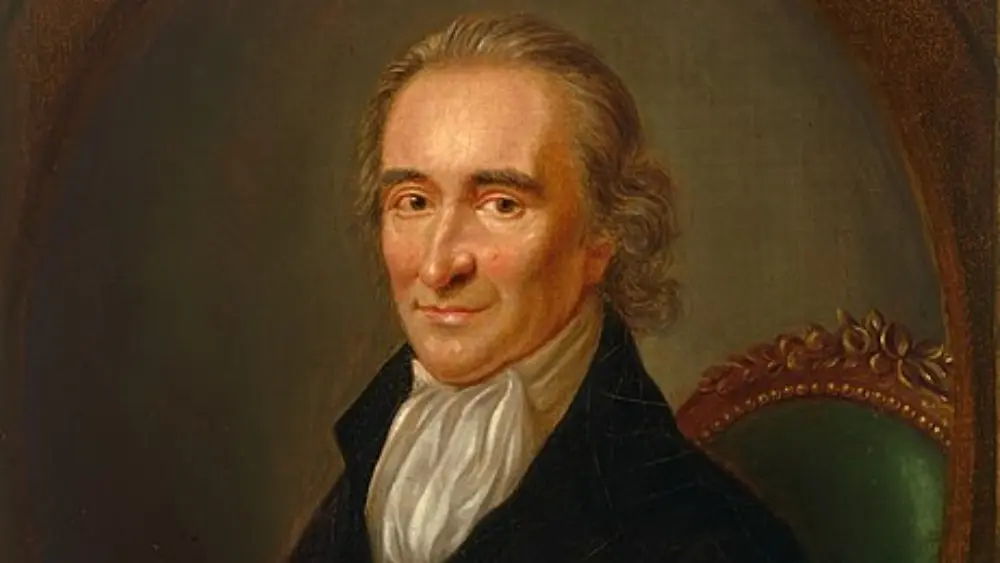Thomas Paine, born on January 29, 1737, in Thetford, England, is renowned as one of the most influential figures of the American and French Revolutions. While Paine is widely celebrated for his pamphlets like “Common Sense” and “The American Crisis,” this biography explores a different facet of his life—his later work, “The Age of Reason.” Published in two parts in 1794 and 1795, this controversial book challenged religious orthodoxy and advocated for reason over faith.
Early Life and Arrival in America
Thomas Paine’s early life was characterized by humble beginnings and a lack of formal education. Born in Thetford, England, in 1737, Paine was the son of a corset maker and a domestic servant, and he had limited opportunities for schooling. Despite his meagre upbringing, Paine exhibited a keen intellect and a fervent desire for knowledge. He worked various jobs, including as an excise officer and a teacher, but it wasn’t until he was in his late thirties that he embarked on a journey that would change the course of his life.
In 1774, Thomas Paine made a significant decision to immigrate to the American colonies, arriving in Philadelphia, a hub of revolutionary spirit. His timing was impeccable, coinciding with rising tensions between colonists and the British crown. In 1776, Paine authored the influential pamphlet “Common Sense,” passionately advocating American independence from British rule, fostering colonial unity and rebellion. Paine’s arrival ignited his enduring legacy as a key propagandist of the American Revolution.
Thomas Paine: The American Crisis
Throughout the tumultuous years of the American Revolution, Thomas Paine played a crucial role in rallying both American troops and civilians with his series of influential pamphlets titled “The American Crisis.” These pamphlets, released at various key points in the war, served as a source of inspiration and motivation for those fighting for American independence. Perhaps the most enduring and well-known words from this series are the opening lines of the first pamphlet: “These are the times that try men’s souls.” These words, penned in late 1776, captured the essence of the dire circumstances faced by the American Revolutionaries and resonated deeply with both soldiers on the battlefield and ordinary citizens facing the hardships of war.
Paine’s “The American Crisis” series was not only a call to arms but also a testament to his persuasive writing skills. His ability to articulate the urgent need for unity and perseverance in the face of adversity provided a crucial morale boost to the American cause. Through these pamphlets, Paine became an enduring symbol of revolutionary spirit, and his words continue to echo through history as a reminder of the resilience and determination of those who fought for American independence. Thomas Paine’s “The American Crisis” remains a timeless testament to the power of words to inspire and uplift in times of great challenge and uncertainty.
The Age of Reason: Part I
Following his involvement in the American Revolution, Thomas Paine ventured back to Europe, where he continued to make waves in the intellectual and philosophical realms. In the late 18th century, he authored a groundbreaking work titled “The Age of Reason: Being an Investigation of True and Fabulous Theology.” This work marked a departure from his earlier revolutionary writings as it delved into the realm of theology and religion. In “The Age of Reason,” Paine unabashedly expressed his deist beliefs, challenging the prevailing religious norms of his time.
Within the pages of “The Age of Reason,” Paine launched a scathing critique of organized religion, with a particular focus on Christianity. He passionately argued for the supremacy of reason over blind faith and vehemently advocated for the rejection of superstitions and religious dogma. Paine’s work championed the idea that individuals should rely on their own capacity for rational thought and scepticism rather than accepting doctrines handed down by religious institutions. “The Age of Reason” was a bold and controversial work that sparked intense debates and solidified Paine’s reputation as a fearless intellectual who fearlessly questioned established religious beliefs and traditions.
Thomas Paine: The Age of Reason Part II:
In 1795, amidst the backdrop of the tumultuous French Revolution, Thomas Paine published the second part of his influential work, “The Age of Reason.” Paine’s decision to release this continuation of his critique of organized religion during a period of intense political upheaval further fueled the controversy surrounding his ideas. In this second instalment, he persisted in his criticism of established religious institutions and doctrines, advocating for a naturalistic and deistic worldview that rejected supernatural explanations and dogma. Paine’s writings during this period reflected his unwavering commitment to promoting reason and rationalism as the guiding principles for understanding the world.
“The Age of Reason Part II” was met with vehement opposition and outrage from religious authorities and conservative elements of society. Paine’s bold and unapologetic challenge to traditional religious beliefs turned him into a lightning rod for controversy, and the religious establishment viewed his work as a threat. Despite the controversy and backlash he faced, Paine’s writings in “The Age of Reason” continue to be regarded as significant contributions to the Enlightenment era’s discourse on religion, reason, and the role of faith in the face of scientific and philosophical progress.
Controversy and Public Response
Thomas Paine’s unflinching critiques of Christianity and organized religion in “The Age of Reason” triggered a firestorm of controversy during his time. Many religious authorities and conservative figures condemned him, going so far as to label him an atheist and a heretic. Paine’s uncompromising stance on rejecting religious dogma and advocating for reason over faith struck a nerve with those who held traditional religious beliefs. Calls for his arrest and accusations of blasphemy became prevalent, making him a polarizing figure in the late 18th century.
However, amidst the backlash, Paine’s work found a receptive audience among individuals who embraced Enlightenment ideals and championed religious tolerance. His writings resonated with those who believed in the power of reason and sought to separate church and state. Paine’s willingness to challenge the status quo and question religious authority contributed to the ongoing conversation about the role of religion in society and the importance of freedom of thought and expression. Despite the controversy that swirled around him, Thomas Paine’s legacy endures as a symbol of intellectual courage and a proponent of the principles of the Enlightenment.

Thomas Paine: Later Years and Legacy
During the later years of his life, Thomas Paine faced significant challenges and fell into relative obscurity. His outspoken and radical views, particularly his unyielding criticism of organized religion, had alienated him from some of his former allies and supporters. Financial difficulties compounded his troubles, and he struggled to maintain a stable livelihood. Despite these hardships, Paine remained committed to his principles and continued to write and advocate for the causes he believed in.
Thomas Paine’s legacy extends far beyond the difficulties he faced in his later years. His writings and ideas played a pivotal role in shaping the intellectual landscape of his time and left a lasting impact on the world. Paine’s advocacy for reason, secularism, and religious freedom had a profound influence on the development of the United States, laying the groundwork for the principle of the separation of church and state enshrined in the First Amendment of the U.S. Constitution. His work also contributed to the broader global movement toward secularism and religious pluralism, championing the idea that individuals should have the freedom to practice their own beliefs without interference from the state or religious institutions. Despite the challenges he encountered in his lifetime, Thomas Paine’s legacy endures as a beacon of enlightenment and a symbol of the enduring struggle for freedom of thought and expression.




